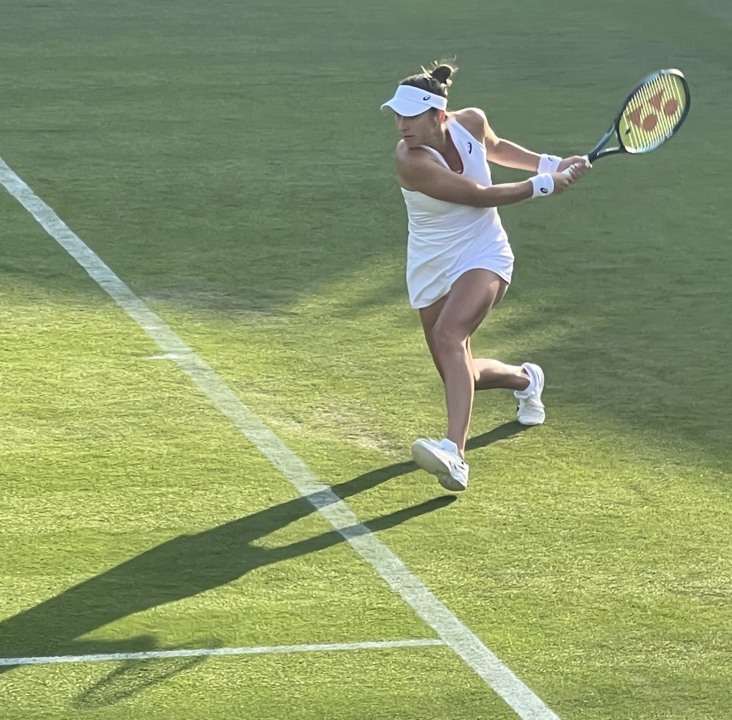
Previous: Trivia Notebook #2
Thanks to all who have suggested trivia topics — you’ve sent me some good ones. Keep them coming. Today I’ve got tidbits on three winners from Indian Wells: Belinda Bencic, Tallon Griekspoor, and Camila Osorio.
Better Belinda Bencic
Great dig from Oleg:
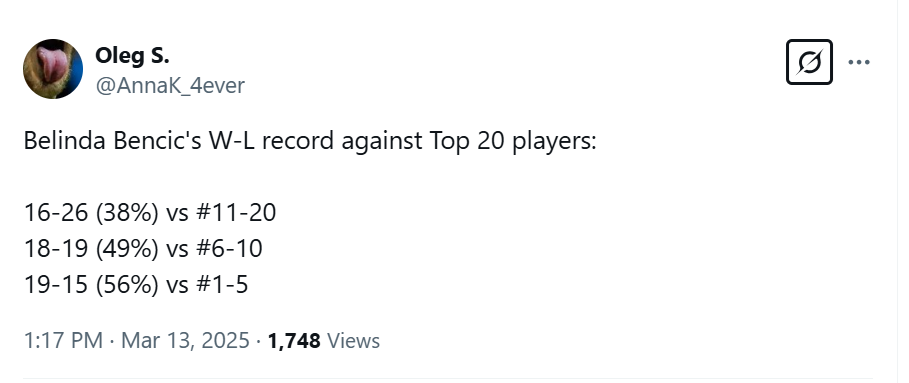
Those numbers include Bencic’s upset of Coco Gauff, but not her loss yesterday to Madison Keys. So the current top-five tally is 19-16, still comfortably better than her record against the next five, or the next ten after that.
The top five typically does not allow things like this. Since 1984, when my week-by-week ranking data begins, the WTA top five has won 79% of matches. That’s a healthy margin ahead of 69% for players ranked 6-10 and 64% for 11-20.
So, is Bencic alone? We’re looking for players with plenty of meetings against each of the three groups. She has 35 or more against each; let’s set the bar lower, at 20. I found 151 such players. Of those, we want to find those who have a better winning percentage against the top five than against the next five, and a better winning percentage against 6-10 than versus 11-20.
No dice. Belinda is the only one. 18 women managed a better record against the top five than the next five:
Player W% v1-5 W% v6-10 Serena Williams 76.5% 62.7% Belinda Bencic 54.5% 48.6% Karolina Pliskova 46.0% 39.5% Jelena Ostapenko 44.8% 37.0% Maria Sakkari 41.2% 39.4% Kristina Mladenovic 40.9% 33.3% Daria Kasatkina 40.5% 24.2% Donna Vekic 37.5% 20.0% Flavia Pennetta 37.2% 28.6% Marion Bartoli 30.2% 29.7% Samantha Stosur 29.0% 26.4% Elise Mertens 25.0% 19.0% Iva Majoli 23.9% 22.6% Katarina Srebotnik 23.8% 20.0% Barbora Strycova 17.9% 9.7% Marianne Werdel Witmeyer 17.4% 13.0% Karina Habsudova 17.2% 11.1% Raffaella Reggi Concato 17.2% 5.9%
(All of these numbers, including Bencic’s, exclude Indian Wells.)
Comparing records against “next five” and “ten after that” is a bit odd in isolation, so instead, let’s compare top-ten and next-ten records. That’s an even more limited group:
Player W% v1-10 W% v11-21 Belinda Bencic 51.4% 35.0% Kiki Bertens 47.9% 38.2% Anett Kontaveit 40.4% 40.0% Kristina Mladenovic 37.0% 34.0% Donna Vekic 27.8% 26.8% Tsvetana Pironkova 25.0% 17.2% Katarina Srebotnik 21.7% 20.8%
Lots of these margins are close; Belinda’s is not. Maybe this explains the recent downward ranking moves of Elena Rybakina and Jasmine Paolini. They fear their colleague from Switzerland, so they’ve fled the top five so as to give her less motivation.
Tallon Griekspoor is no Bencic
Heading to the desert, Tallon Griekspoor held a 0-18 career record against the top five:
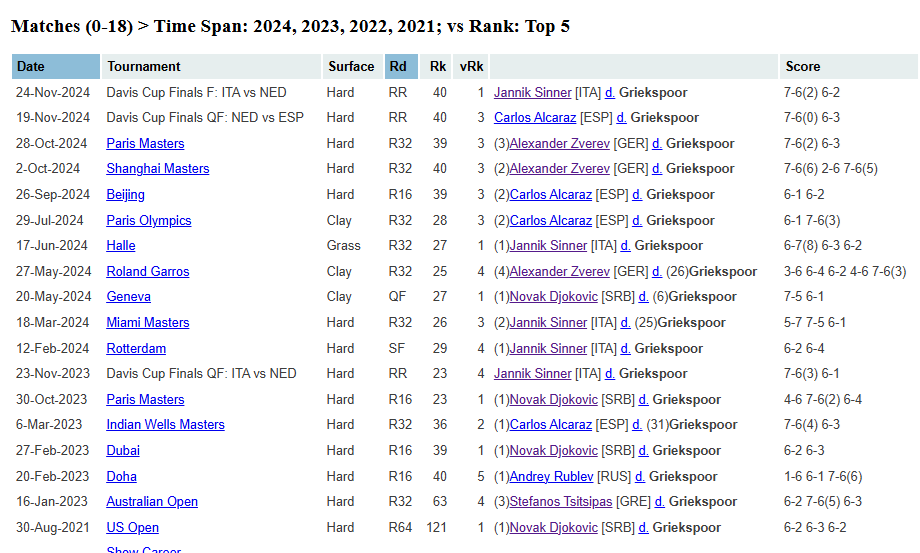
Some good fights in there, but a zero is a zero. That changed last Friday, when the Dutchman outlasted Alexander Zverev in a third-set tiebreak. Zverev has given several men a top-five victory in the last few weeks, but it still counts.
We have a few questions, then:
- Is Griekspoor’s top-five losing streak the longest ever to start a career?
- Is it the longest to be broken?
- How does it compare to top-five losing streaks, including those that don’t start a career?
Losing your first 18 matches against top-fivers gets you into the conversation, but Griekspoor stopped five defeats short of the record. These numbers all go back to 1982, the first year for which I have week-by-week ATP rankings. Here’s the all-time list:
Player Losses Broken? Fabio Fognini 23 Yes Jeff Tarango 23 No Jarkko Nieminen 23 Yes Simone Bolelli 22 Yes Diego Schwartzman 22 Yes Francisco Clavet 21 Yes Potito Starace 20 No Tomas Carbonell 20 Yes Victor Hanescu 19 No Tallon Griekspoor 18 Yes Leonardo Mayer 18 No Ryan Harrison 18 No Alex De Minaur 18 Yes
It’s easy to dunk on Fabio Fognini, but in fairness, he came up at a very difficult time to score a top-five win. Check out the list of opponents for those 23 losses:
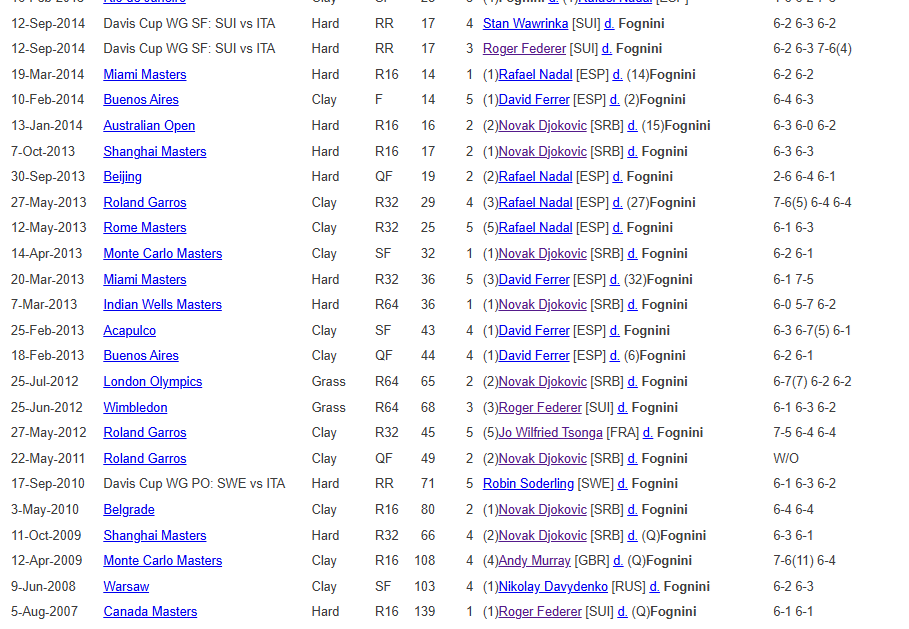
And yes, after all that, Fognini ended the string by beating Nadal. On clay. Twice.
I also need to mention Tomas Carbonell. He ended his 20-match losing streak with an upset of 5th-ranked Jonas Bjorkman … and that was it! He finished his career on at least one winning streak.
What about top-five losing streaks, not limited to those at the beginning of a career? Here are the longest runs of top-five futility, again going back to 1982:
Player Streak Andreas Seppi 32 Viktor Troicki 28 Philipp Kohlschreiber 27 Jeff Tarango 23 * Fabio Fognini 23 * Jarkko Nieminen 23 * Jimmy Connors 23 Eliot Teltscher 22 Simone Bolelli 22 * Diego Schwartzman 22 * Andres Gomez 22 Marin Cilic 22 Gilles Muller 22 Francisco Clavet 21 *
(Starred players are those from the previous list.)
Before we get to Seppi, Teltscher deserves an honorable mention here. His 22-loss streak started in early 1982, right after he upset John McEnroe at the season-ending Masters event. Had he lost that match, the string would have extended to 34, since the McEnroe upset broke a separate 11-loss streak.
Seppi’s long run of frustration would have been hard to predict: He had beaten Lleyton Hewitt and Nadal before he broke into the top 40 himself. But the 2008 victory over Rafa would be his last top-five win for nearly seven years:
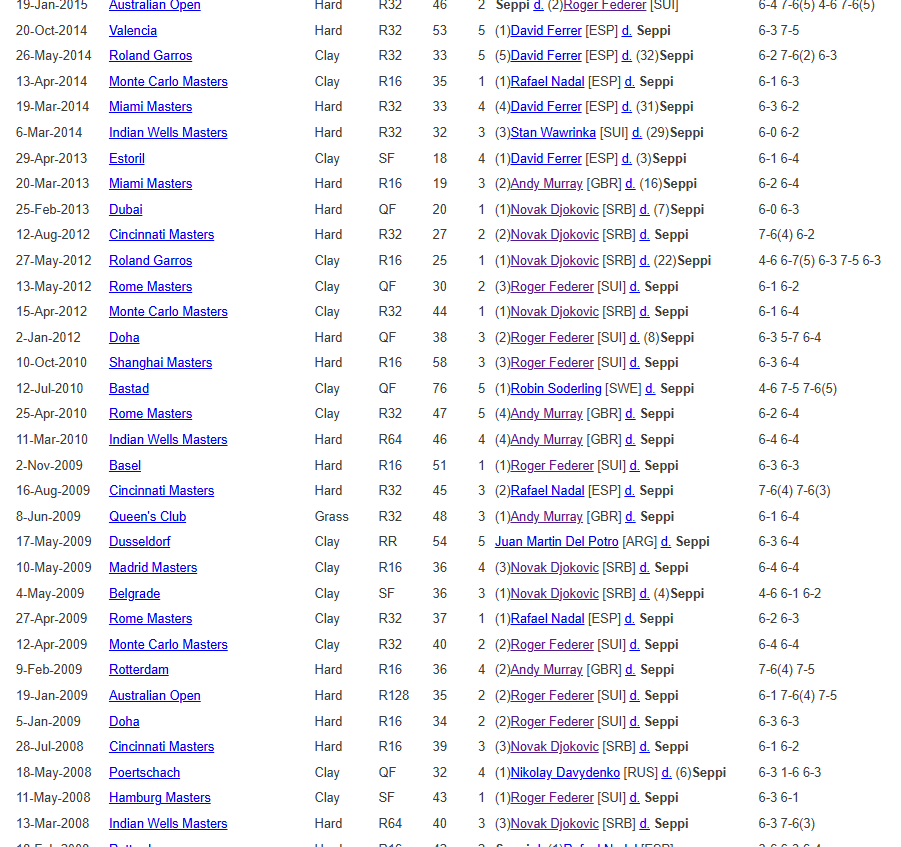
As with Fognini, not an easy time to knock out anybody in the top five.
Finally, did you notice Jimmy Connors on the list? He is by far the greatest player to suffer such a long losing streak, and it was all the more notable because it began when he was a top-two player himself. He was responsible for 15 of Teltscher’s losses, but by 1985, things turned south for Jimbo:
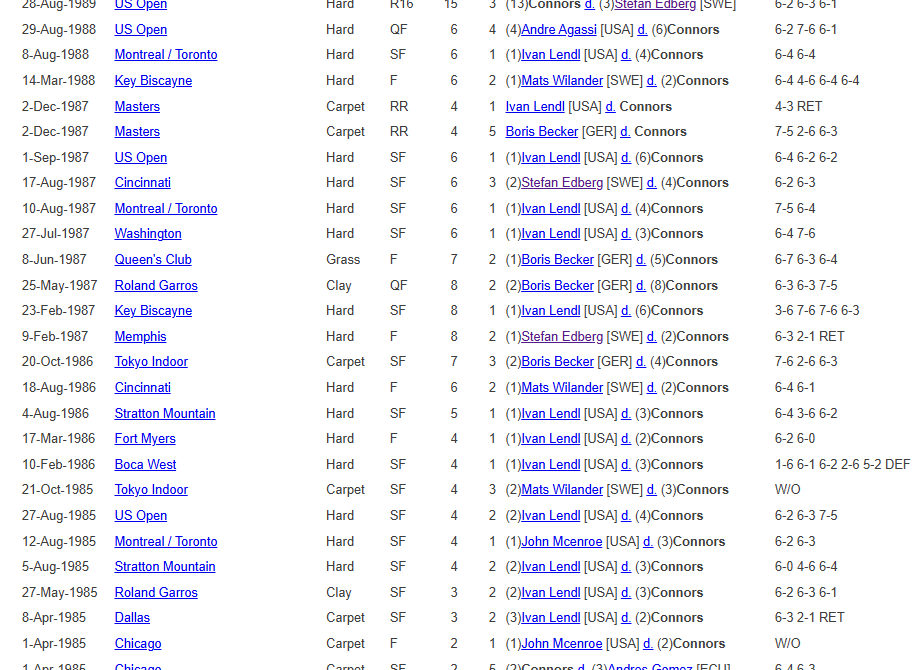
Connors was 32 years old when the streak began, so it didn’t entirely come out of the blue. Still, that’s a tough run for a top-ten player.
Defeats of former number ones
Camila Osorio opened her Indian Wells campaign with a straight-set win over Naomi Osaka. It wasn’t exactly a shock, as Osorio is ranked slightly above Osaka. But here’s a different spin on it:
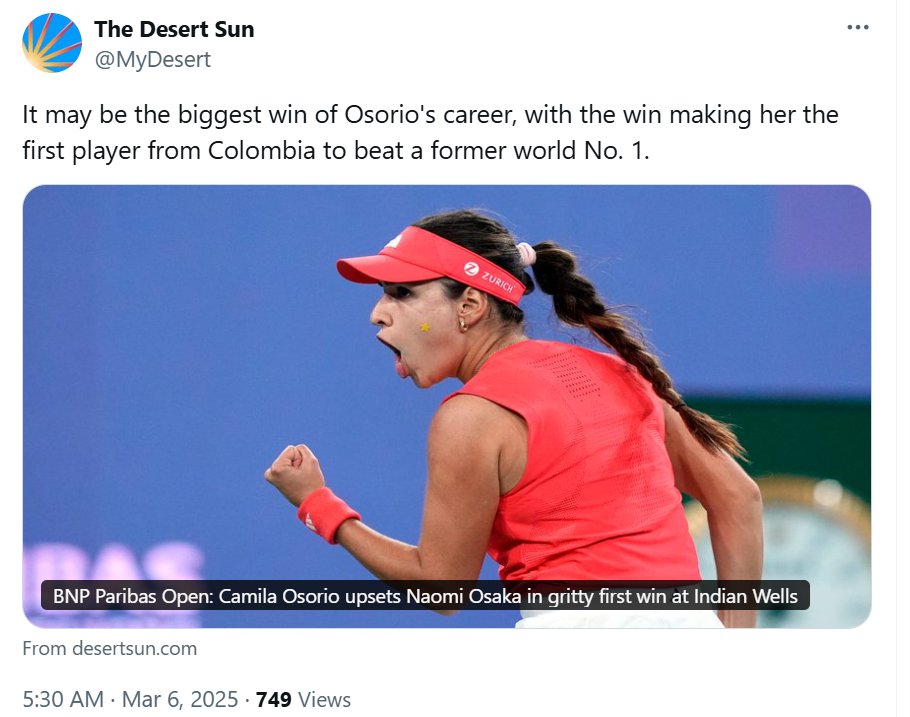
Is this something we’re doing now? I mean, great for Camila and Colombia–I’m always happy to see a tennis non-powerhouse getting attention. But “former number one” spans a fair few players, some of whom have stuck around long after they fell from the top of the list. Victoria Azarenka alone has lost over 100 matches since she first dropped out of the top ten in 2014.
Still, what the hell, let’s play.
Going back to 1984, there have been 27 WTA number ones. I’m going to count wins against the current number one as well–presumably those are at least as noteworthy as beating a former top player. Since the beginning of my week-by-week ranking data, current or former number ones have lost 2,587 matches.
Here are the stars who have handed out the largest number of noteworthy(?) victories. Unlike some loss leaderboards, this isn’t necessarily a bad thing. Azarenka is a good example: Inclusion here says more about longevity than anything else. So, losses after first reaching the number one ranking:
Player Losses Venus Williams 219 Jelena Jankovic 205 Caroline Wozniacki 192 Arantxa Sanchez Vicario 168 Ana Ivanovic 162 Victoria Azarenka 142 Karolina Pliskova 131 Maria Sharapova 130 Serena Williams 116 Angelique Kerber 114
Osorio represented Osaka’s 49th such loss. Venus Williams has allowed 108 different women to put “beat a former number one” on their CV, and Osaka is already up to 33.
All told, 369 women have now beaten a current or former number one in the last four decades. They represent 52 different countries, now including Colombia.
It really isn’t that elite of a group. Osorio has better achievements to brag about, including–to bring us full circle–a top-five win, one that took her far fewer than 18 tries to accomplish.
* * *
Subscribe to the blog to receive each new post by email:

